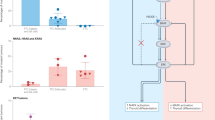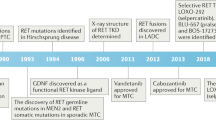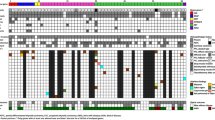Abstract
Distinct dominant activating mutations in the RET proto-oncogene are responsible for the development of multiple endocrine neoplasia type 2 (MEN 2). Concise examination of the mutated codons led to the detection of a striking genotype–phenotype correlation between the mutated codon and the MEN 2 phenotype in terms of onset and aggressiveness of the disease, suggesting that manifestation and clinical progression is conditioned by the type of mutation. To gain insight into the molecular basis for this genotype–phenotype correlation, we analysed the impact of common and rare mutations identified in MEN 2A (C609Y, C634R), MEN 2B (A883F, M918T) and familial medullary thyroid carcinoma (Y791F) patients on several aspects of cell transformation, including proliferation, apoptosis, anchorage-independent growth and signaling. We found that tumor cells arising from distinct extracellular or intracellular MEN 2 mutations clearly differ in their proliferation properties owing to the activation of different molecular pathways, but importantly, also in resistance to apoptosis. Whereas MEN 2A mutants resulted in accelerated cell proliferation, MEN 2B-RET mutants significantly enhanced suppression of apoptosis, which may account, at least partially, for some of the clinical differences in MEN 2 patients.
This is a preview of subscription content, access via your institution
Access options
Subscribe to this journal
Receive 50 print issues and online access
$259.00 per year
only $5.18 per issue
Buy this article
- Purchase on Springer Link
- Instant access to full article PDF
Prices may be subject to local taxes which are calculated during checkout






Similar content being viewed by others
References
Airaksinen MS, Saarma M . (2002). Nat Rev Neurosci 3: 383–394.
Arighi E, Borrello MG, Sariola H . (2005). Cytokine Growth Factor Rev 16: 441–467.
Asai N, Iwashita T, Matsuyama M, Takahashi M . (1995). Mol Cell Biol 15: 1613–1619.
Asai N, Murakami H, Iwashita T, Takahashi M . (1996). J Biol Chem 271: 17644–17649.
Besset V, Scott RP, Ibanez CF . (2000). J Biol Chem 275: 39159–39166.
Bocciardi R, Mograbi B, Pasini B, Borrello MG, Pierotti MA, Bourget I et al. (1997). Oncogene 15: 2257–2265.
Carlson KM, Dou S, Chi D, Scavarda N, Toshima K, Jackson CE et al. (1994). Proc Natl Acad Sci USA 91: 1579–1583.
Davis RJ . (2000). Cell 103: 239–252.
Donis-Keller H, Dou S, Chi D, Carlson KM, Toshima K, Lairmore TC et al. (1993). Hum Mol Genet 2: 851–856.
Drosten M, Hilken G, Bockmann M, Rodicker F, Mise N, Cranston AN et al. (2004). J Natl Cancer Inst 96: 1231–1239.
Durbec PL, Larsson-Blomberg LB, Schuchardt A, Costantini F, Pachnis V . (1996). Development 122: 349–358.
Edery P, Lyonnet S, Mulligan LM, Pelet A, Dow E, Abel L et al. (1994). Nature 367: 378–380.
Freche B, Guillaumot P, Charmetant J, Pelletier L, Luquain C, Christiansen D et al. (2005). J Biol Chem 280: 36584–36591.
Gimm O, Niederle BE, Weber T, Bockhorn M, Ukkat J, Brauckhoff M et al. (2002). Surgery 132: 952–959; discussion 959.
Hanahan D, Weinberg RA . (2000). Cell 100: 57–70.
Hansford JR, Mulligan LM . (2000). J Med Genet 37: 817–827.
Hess P, Pihan G, Sawyers CL, Flavell RA, Davis RJ . (2002). Nat Genet 32: 201–205.
Hofstra RM, Landsvater RM, Ceccherini I, Stulp RP, Stelwagen T, Luo Y et al. (1994). Nature 367: 375–376.
Ichihara M, Murakumo Y, Takahashi M . (2004). Cancer Lett 204: 197–211.
Iwamoto T, Taniguchi M, Asai N, Ohkusu K, Nakashima I, Takahashi M . (1993). Oncogene 8: 1087–1091.
Jijiwa M, Fukuda T, Kawai K, Nakamura A, Kurokawa K, Murakumo Y et al. (2004). Mol Cell Biol 24: 8026–8036.
Kurokawa K, Kawai K, Hashimoto M, Ito Y, Takahashi M . (2003). J Intern Med 253: 627–633.
Le Hir H, Charlet-Berguerand N, Gimenez-Roqueplo A, Mannelli M, Plouin P, de Franciscis V et al. (2000). Oncology 58: 311–318.
Manie S, Santoro M, Fusco A, Billaud M . (2001). Trends Genet 17: 580–589.
Marshall GM, Peaston AE, Hocker JE, Smith SA, Hansford LM, Tobias V et al. (1997). Cancer Res 57: 5399–5405.
Marx SJ . (2005). Nat Rev Cancer 5: 367–375.
Meng X, Lindahl M, Hyvonen ME, Parvinen M, de Rooij DG, Hess MW et al. (2000). Science 287: 1489–1493.
Moroy T, Geisen C . (2004). Int J Biochem Cell Biol 36: 1424–1439.
Mulligan LM, Kwok JB, Healey CS, Elsdon MJ, Eng C, Gardner E et al. (1993). Nature 363: 458–460.
Murakami H, Yamamura Y, Shimono Y, Kawai K, Kurokawa K, Takahashi M . (2002). J Biol Chem 277: 32781–32790.
Plaza Menacho I, Koster R, van der Sloot AM, Quax WJ, Osinga J, van der Sluis T et al. (2005). Cancer Res 65: 1729–1737.
Reynolds L, Jones K, Winton DJ, Cranston A, Houghton C, Howard L et al. (2001). Oncogene 20: 3986–3994.
Salvatore D, Melillo RM, Monaco C, Visconti R, Fenzi G, Vecchio G et al. (2001). Cancer Res 61: 1426–1431.
Santoro M, Carlomagno F, Melillo RM, Fusco A . (2004). Cell Mol Life Sci 61: 2954–2964.
Santoro M, Carlomagno F, Romano A, Bottaro DP, Dathan NA, Grieco M et al. (1995). Science 267: 381–383.
Schuchardt A, D'Agati V, Larsson-Blomberg L, Costantini F, Pachnis V . (1994). Nature 367: 380–383.
Segouffin-Cariou C, Billaud M . (2000). J Biol Chem 275: 3568–3576.
Smith-Hicks CL, Sizer KC, Powers JF, Tischler AS, Costantini F . (2000). EMBO J 19: 612–622.
Takahashi M . (2001). Cytokine Growth Factor Rev 12: 361–373.
Takahashi M, Asai N, Iwashita T, Murakami H, Ito S . (1998). J Intern Med 243: 509–513.
Thimmaiah KN, Easton JB, Germain GS, Morton CL, Kamath S, Buolamwini JK et al. (2005). J Biol Chem 280: 31924–31935.
Tsui-Pierchala BA, Ahrens RC, Crowder RJ, Milbrandt J, Johnson Jr EM . (2002). J Biol Chem 277: 34618–34625.
Vitale G, Caraglia M, Ciccarelli A, Lupoli G, Abbruzzese A, Tagliaferri P . (2001). Cancer 91: 1797–1808.
Vivanco I, Sawyers CL . (2002). Nat Rev Cancer 2: 489–501.
Watanabe T, Ichihara M, Hashimoto M, Shimono K, Shimoyama Y, Nagasaka T et al. (2002). Am J Pathol 161: 249–256.
Welcker M, Singer J, Loeb KR, Bloecher A, Gurien-West M, Clurman BE et al. (2003). Mol Cell 12: 381–392.
Yip L, Cote GJ, Shapiro SE, Ayers GD, Herzog CE, Sellin RV et al. (2003). Arch Surg 138: 409–416; discussion 416.
Acknowledgements
We thank Heike Bergmann for preparation of immunohistological sections. This work was supported by DFG Grant PU 188/3-3 (BMP).
Author information
Authors and Affiliations
Corresponding author
Additional information
Supplementary Information accompanies the paper on the Oncogene website (http://www.nature.com/onc).
Rights and permissions
About this article
Cite this article
Miše, N., Drosten, M., Racek, T. et al. Evaluation of potential mechanisms underlying genotype–phenotype correlations in multiple endocrine neoplasia type 2. Oncogene 25, 6637–6647 (2006). https://doi.org/10.1038/sj.onc.1209669
Received:
Revised:
Accepted:
Published:
Issue Date:
DOI: https://doi.org/10.1038/sj.onc.1209669
Keywords
This article is cited by
-
MiR-182 promotes cancer invasion by linking RET oncogene activated NF-κB to loss of the HES1/Notch1 regulatory circuit
Molecular Cancer (2017)
-
Differences in the transcriptome of medullary thyroid cancer regarding the status and type of RET gene mutations
Scientific Reports (2017)
-
The RET E616Q Variant is a Gain of Function Mutation Present in a Family with Features of Multiple Endocrine Neoplasia 2A
Endocrine Pathology (2017)
-
Medullary Thyroid Carcinoma: Recent Advances Including MicroRNA Expression
Endocrine Pathology (2016)
-
RET revisited: expanding the oncogenic portfolio
Nature Reviews Cancer (2014)



